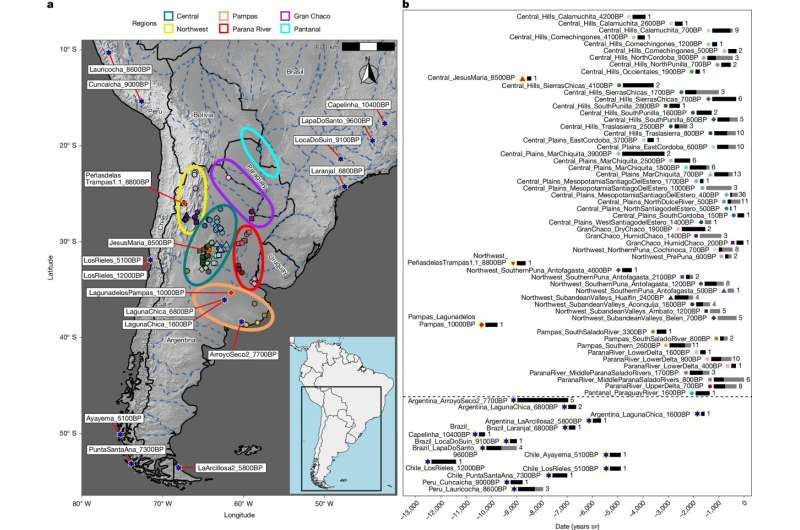Science
Ancient DNA Reveals 8,500-Year-Old Lineage in Argentina

Researchers have discovered a previously unknown genetic lineage in Argentina that has persisted for at least 8,500 years. This finding, published in the journal Nature, provides new insights into the ancient populations of the central Southern Cone, a region that has remained relatively underexplored in genetic research.
The central Southern Cone, which encompasses a significant part of Argentina, is recognized as one of the last regions globally to be populated by humans. While evidence suggests that migration to this area occurred over 12,000 years ago, there has been a notable lack of genetic studies detailing the lineages in this specific region. A team of DNA researchers aimed to address this gap by conducting a comprehensive genome-wide analysis of ancient individuals from the area.
Decoding Ancient DNA
The research team analyzed a total of 344 bone and tooth samples from 310 individuals who lived between 10,000 and 150 years ago. They successfully obtained genome-wide data from 238 individuals, enriching ancient DNA libraries for over 1.2 million targeted single-nucleotide polymorphisms (SNPs). This allowed them to compare their findings with data from 588 pre-European contact Native Americans and present-day Native Americans.
According to the study authors, “The peopling of South America likely followed both the Pacific and Atlantic coasts.” They identified three major genetic clusters that emerged after 9,000 years ago: the central Andes, tropical/subtropical lowlands including the Amazon, and central Chile, Patagonia, and the Pampas.
The new study revealed a deep genetic lineage in central Argentina that coexisted with other groups and became predominant in the Pampas region after 800 years ago. This lineage has shown remarkable continuity over thousands of years, even surviving significant climatic challenges such as prolonged droughts.
Understanding Genetic Connectivity
The team’s analysis highlighted genetic connections between the inhabitants of central Argentina and central Andes lineages dating back to 4,600 years ago. The findings indicate that while the lineage interacted with others, it largely maintained its genetic homogeneity. The researchers noted evidence of increased close-kin unions in northwest Argentina, which correlates with similar practices observed in the central Andes.
This phenomenon may be attributed to a kinship-based social structure, often referred to as the ayllu system. This system promotes community cohesion through rules of kinship affiliation and reciprocity, encouraging marriages within the group to enhance cooperation and resource sharing.
The study contributes significantly to the understanding of Indigenous population history in Argentina and the Southern Cone, helping to fill in crucial gaps in the region’s historical narrative. The researchers emphasize the need for future studies that sample more densely across various regions and time periods to further clarify migration patterns and genetic admixture.
This groundbreaking research, led by Javier Maravall-López and his team, underscores the importance of ancient DNA studies in unraveling the complex history of human populations in South America. As the scientific community continues to explore these ancient connections, a deeper appreciation of the cultural and genetic heritage of Argentina is emerging.
-

 World3 weeks ago
World3 weeks agoGlobal Air Forces Ranked by Annual Defense Budgets in 2025
-

 World3 weeks ago
World3 weeks agoMass Production of F-35 Fighter Jet Drives Down Costs
-

 Science3 weeks ago
Science3 weeks agoTime Crystals Revolutionize Quantum Computing Potential
-

 World3 weeks ago
World3 weeks agoElectrification Challenges Demand Advanced Multiphysics Modeling
-

 Lifestyle3 weeks ago
Lifestyle3 weeks agoDiscover Reese Witherspoon’s Chic Dining Room Style for Under $25
-

 Top Stories3 weeks ago
Top Stories3 weeks agoDirecTV to Launch AI-Driven Ads with User Likenesses in 2026
-

 Top Stories3 weeks ago
Top Stories3 weeks agoNew ‘Star Trek: Voyager’ Game Demo Released, Players Test Limits
-

 Entertainment3 weeks ago
Entertainment3 weeks agoFreeport Art Gallery Transforms Waste into Creative Masterpieces
-

 Health3 weeks ago
Health3 weeks agoGavin Newsom Critiques Trump’s Health and National Guard Plans
-

 Politics1 week ago
Politics1 week agoLanguage Evolution: New Words Spark Confusion in Communication
-

 Lifestyle3 weeks ago
Lifestyle3 weeks agoLia Thomas Honored with ‘Voice of Inspiration’ Award at Dodgers Event
-

 Business3 weeks ago
Business3 weeks agoGold Investment Surge: Top Mutual Funds and ETF Alternatives









